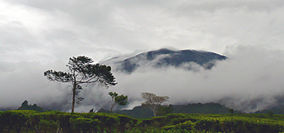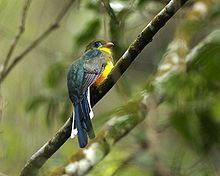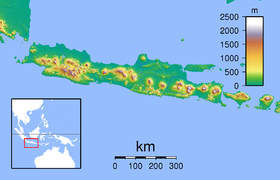- Gunung Gede Pangrango National Park
-
Gunung Gede Pangrango National Park IUCN Category II (National Park)
View of Gunung Gede from the nearby tea plantationLocation in Java Location West Java, Indonesia Nearest city Bogor Coordinates 6°46′0″S 106°56′0″E / 6.766667°S 106.933333°ECoordinates: 6°46′0″S 106°56′0″E / 6.766667°S 106.933333°E Area 151.96 km² Established 1980 Governing body Ministry of Forestry Mount Gede Pangrango National Park is a national park in West Java, Indonesia. The park is centred on two volcanoes—Mount Gede and Mount Pangrango— and is 150 km² in area.[1]
It evolved from already existing conservation areas, such as Cibodas Nature Reserve, Cimungkat Nature Reseve, Situgunung Recreational Park and Mount Gede Pangrango Nature Reserve, and has been the site of important biological and conservation research over the last century.[1] In 1977 UNESCO declared it part of the World Network of Biosphere Reserves.[2]
Contents
Topography and ecology
 The Javan Trogon found in the national park, is an endangered species endemic to West Java
The Javan Trogon found in the national park, is an endangered species endemic to West Java
Mount Gede (2,958 m) and Pangrango (3,019 m) are twin volcanoes. The two summits are connected by a high saddle known as Kandang Badak (2,400 m). The mountain slopes are very steep and are cut into rapidly flowing stream, which carve deep valleys and long ridges.
Lower and upper montane and subalpine forests are within the park and have been well studied. To the north of Mount Gede is a field of Javanese Edelweiss (Anaphalis javanica). The park contains a large number of species known to occur only within its boundaries, however, this may be a result of the disproportionate amount of research over many years.[1]
Flora and fauna
Gunung Gede-Pangrango is inhabited by 251 of the 450 bird species found in Java. Among these are endangered species like the Javan Hawk-eagle and the Javan Scops Owl.[2]
Among the endangered mammal species in the Park there are several primates such as the Silvery Gibbon, Javan Surili and Javan Lutung. Other mammals include Leopard, Leopard Cat, Indian Muntjac, Java Mouse-deer, Dhole, Malayan Porcupine, Sunda Stink Badger, and Yellow-throated Marten.[2]
Tourism
Visitors usually enter the park by one of the four gates of the park: the Cibodas, Gunung Putri, and Selabintana gates, all give access to the peaks; the Situ Gunung gate gives entrance to a lake area set aside mainly for family-style recreation. Cibodas gate is the most popular entrance gate and is the site of the park's headquarters. From Jakarta, the area is two hours drive, usually via Cibodas Botanical Gardens.
See also
- Volcanoes of Indonesia
- Geography of Indonesia
References
External links
National parks of Indonesia Bali and Nusa Tenggara Java Alas Purwo · Baluran · Bromo Tengger Semeru · Gunung Ciremai · Gunung Gede Pangrango · Gunung Halimun · Gunung Merapi · Gunung Merbabu · Karimunjawa · Kepulauan Seribu · Meru Betiri · Ujung KulonKalimantan Betung Kerihun · Bukit Baka Bukit Raya · Danau Sentarum · Gunung Palung · Kayan Mentarang · Kutai · Sabangau · Tanjung PutingMaluku and Papua Sulawesi Bantimurung-Bulusaraung · Bogani Nani Wartabone · Bunaken · Kepulauan Togean · Lore Lindu · Rawa Aopa Watumohai · Taka Bone Rate · WakatobiSumatra Batang Gadis · Berbak · Bukit Barisan Selatan · Bukit Duabelas · Bukit Tigapuluh · Gunung Leuser · Kerinci Seblat · Sembilang · Siberut · Tesso Nilo · Way KambasCategories:- IUCN Category II
- National parks of Indonesia
- West Java
Wikimedia Foundation. 2010.

